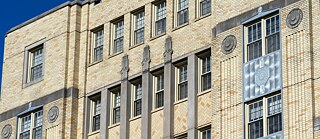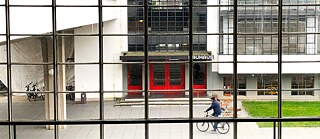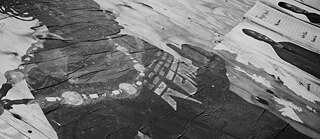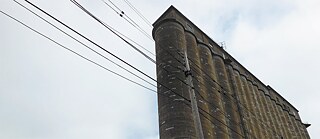Architektur und Leben
How Buildings Mean
Alex van Oss sinniert über äußere, innere und ewige Bedeutungen von Gebäuden in seinem Washingtoner Viertel. Dafür spricht er auch mit Freund*innen und Nachbar*innen, was seine sehr persönliche Sichtweise auf Architektur hervorbringt.
Diese Folge anhören: Apple Music | Spotify | Download
Diese Folge stammt von Alex van Oss, der seit vier Jahrzehnten für das National Public Radio (NPR) und andere Sender als Journalist und Produzent arbeitet. Von 2003 bis 2014 koordinierte er die Caucasus Area Studies für das U.S. State Department’s Foreign Service Institute. Schon immer hat Alex die großen deutschen Dichter*innen und Denker*innen bewundert. Er übernahm sogar die Rolle des deutschen Schriftstellers Bertolt Brecht in einer Highschool‑Theaterproduktion. In dieser Episode nimmt Alex die Zuhörer*innen mit auf eine Reise durch Washington, D.C. und besucht die architektonisch ikonischsten Gebäude der Stadt. Peter Waddell, ein Künstler mit Fokus auf Gebäudeporträts der U.S.-Hauptstadt, sowie der Autor Gary Lee teilen ihre Gedanken in dieser Episode. Das Foto zur Folge hat Mike Maguire aufgenommen, es zeigt die Kennedy‑Warren‑Apartments in Washington. Außer der Folge „How Buildings Mean“ hat Alex van Oss „The Colossi of Buffalo“ und „The Library and the Book“ produziert.
Transkript
[A TONE]
Alex van Oss: ‘How Buildings Mean’ — what does that mean and what building?
[FAKE WIND, A BLIZZARD]
Alex van Oss: The Taj Mahal, or the Great Pyramid, or the art museum north of the Arctic Circle in Rovaniemi, Finland, with a door handle so human, so touching, so something. Its architect, its designer, a Finn — Juhani Pallasmaa — says: a door handle is the handshake of the building. Yes ... how do you do?
[WIND STOPS. CREAKS, STEPS, DOOR, HALLWAY, STAIRCASE, DOOR, OUTDOOR STEPS]
Alex van Oss: But there is no India, no Giza, no Finland, right here, right now. Just this room, these eye-windows, this handshake doorknob, this hall, this building, step by step, out toward another building, toward history, a block away, to a place called Woodley, Woodley mansion, built by slaves on the cool high-ground above Washington, just a block away. Now it’s a prep school: Maret.
[OUTDOORS, CHILDREN PLAYING]
Al Kilborne: It was on a piece of ground called ‘Pretty Prospect’ because of the view down below, of the incipient city, but it was named for a house in England. It was Woodley Lodge.
Alex van Oss: Historian Al Kilborne used to teach here at this school, Maret. He says the old Woodley Mansion was home to the elite — senators, Cabinet members like Henry Stimson, generals like George Patton ... and Presidents — Van Buren, Buchanan, Grover Cleveland. In short, the school building simply is history.
Al Kilborne: For me just personally it’s a Memory Palace. Because as I walk into, for example the computer room, that was once Henry Stimson’s study, I could almost feel him sitting down and hearing Franklin Roosevelt’s voice talking about Pearl Harbor having just been bombed.
Alex van Oss: Woodley Mansion used to have two floors. But now it has three — thanks to Alaska, and some bribe money in the 1800’s from Russia, for Congress.
Al Kilborne: Alexander II, who was the tsar of Russia, had a piece of real estate that he wanted to unload. And the American Congress was very skeptical about that. But our Secretary of State, a man named Seward, thought that there were great future possibilities to this barren wasteland up to the north. Congress just shook their head, they called this land ‘Seward’s Icebox,’ — ‘Seward’s Folly.’ So Alexander II knew there was one person who might be able to move the general mood of the Congress, and his name was Robert Walker, living at Woodley, described as a mere ‘whiffet of a man’ but he was a mere whiffed of a man who cast a long shadow. So Alexander II gave little Robert Walker $26,000 in hard, cold Russian gold, and he said, go grease a few palms. And lo and behold we ended up buying Alaska, but now Robert Walker had enough to add to Woodley, so he put the third floor under the central section, and the second floor onto the two side sections, and so it was at that time that Woodley assumed the silhouette that it has today.
Alex van Oss: Woodley Mansion, Maret, has students and teachers today, and also maybe some mysterious visitors from the past. Al Kilborne says that sometimes doors open and close unexpectedly, and there are curious whiffs of tobacco — and then there’s the Woman-in-White.
Al Kilborne: Yes, actually I was a party to a ghost story. And that was that a night watchman, during November, came up to me in the morning, and he said something very strange had happened. And I said what happened, and he said well the evening before, he said, he went out, and there was a bench out front at Woodley, and there was a woman who was sitting on the bench, and she was in a long white dress. And he couldn’t understand why she wasn’t in a coat, because it was a cool night. And anyway, he looked to see what sort of a car had brought her, and when he looked back she had disappeared. I took him inside of Woodley, and in what was the Woodley main room, the parlor, there was a portrait of Anne Plater Key, who was the wife of the first owner and the builder of Woodley, and I said, did that woman that you saw look anything like her? And he reacted so strongly, he said, that was the woman!
Alex van Oss: Kilborne says that in 1832, Anne Plater Key — perhaps the Woman-in-White — opened the doors of Woodley to the public. It was the year a cholera epidemic killed 100,000 Washingtonians. Ann Plater Key offered hospitality to citizens fleeing the city. They could stay at Woodley — if they paid, and if they brought their own bedding.
[A-TONE, WIND]
Alex van Oss: It’s said that in life, or in memory, sooner or later every door, every room connects with every other room. And sooner or later the door opens to the hidden ballroom of Versailles. So many rooms in Versailles, so many unused rooms, dusty, under wraps. And this hidden ballroom years ago went missing! In Versailles! How on earth? No one knows when, or even if, but it must be there, somewhere, in Versailles, or somewhere.
Susan Stamberg: It’s here, it’s in the Kennedy-Warren! [LAUGHS] Here they call it the Warren Room, and I bet you it was the old ballroom. You know, in the day, and I bet there were big parties back there. But I have taken free Saturday-morning yoga classes in that room.
Alex van Oss: Longtime broadcast journalist Susan Stamberg lives down the street from Woodley Mansion, in another historical building — the vast old Kennedy-Warren Apartments — a 1930’s art deco masterpiece with parlors and a ballroom and a façade that glows in the sunset.
Susan Stamberg: The light is my salvation in this pandemic, I have to say, because NPR, where I work, is in lockdown. So we’re all working from home. I’ve never done that in my life. But this apartment is walled with windows.
Alex van Oss: It offers light and views and community.
Susan Stamberg: I was in the same Sears-Roebuck house in Washington, D.C., my husband and I, and our, then, brand-new son, for 46 years. And my husband always called it our ‘starter home.’ He died in 2007, and we had spent about three years before that looking pretty much in every apartment building in this city. Never here, never in the Kennedy-Warren, by the way, but all kinds of other places, and never saw one that pleased both of us in the same way. But on his death-bed he said to me, get out of this house! He was worried about me having to be responsible for a house, because he knew how ignorant I was about what you needed to do. The house was in perfectly good, well, decent shape, anyway, but that’s what he said. I do have to tell you a couple of stories about community, which is also extraordinary. I grew up in an apartment and it was like, in Manhattan, and it was like a vertical village, that is: you knew your neighbors, and my mother made a best friend, we were on the ninth floor and the best friend was, I think, on 12, and those women would go up and down on elevators to see each other and have visits, and there was another neighbor across the hall who became a close friend of hers, and a classmate of mine in sixth grade’s father was the superintendent of that building. So Delores was downstairs and I would go down and see her sometimes, too. So it was sort of internal friend-making and knowing of one another, but what I’ve discovered here is, to me, extraordinary: a sense of community and community-making that I never expected. I posted — we have a listserv for the building — and I posted during the pandemic a note asking if anyone made regular runs to Trader Joe’s and/or Costco and would be willing to pick up a few things for me, please get in touch. I got eight responses, eight of them, and they were all strangers, I didn’t know any of them. Again I thought, oh that would never happen in New York, never, never! The building has its quirks, you know, and the quirkiest thing I think, well, it’s wonderful that we are allowed to have pets here and many, many people do. The ones I see are dogs, but none of those four little feet, or big ones, are allowed to touch the ground of any public space. Very nice carpets and they are to be preserved, and so strewn throughout the building, mostly off the lobby, or maybe in people’s apartments, too, are strollers, babies’ strollers, and you’ll be in the lobby and the elevator doors will open, and out comes a child’s stroller and poking outside of it are these [PANTS, LAUGHS] little furry faces who can’t wait to get outside. That’s quirky!
[A-TONE, STRANGE CLANGS, WHOOSHING SOUNDS, SOME WORDS OVERLAP]
Alex van Oss: ‘How Buildings Mean’ What does ‘building’ mean? What does ‘mean’ mean, Heidegger ... hmm? Bildung ... building — no! Building ... Bildung — no ... no way ... nein ... nicht ... kein! Uh-uh! But ... history ... Historie ... Geschichte ... Historisch ... historiography ... historiology ... historical ... historiographical ... historiological ... ‘history-ish’ ... no! Tsk-tsk — Heidegger! Being ...
[TONE]
Alex van Oss: ... Dasein ... be-ing
[TONES]
Alex van Oss: ... beee-ing
[A-TONE]
Alex van Oss: ... ing
[A-TONE]
Alex van Oss: ... Dasein ... design ... ist! ... design ... is ... Geschichtlich ... Dasein ... is ... ‘history-ish’ ... de-sign ... duh ... sign ... Dasein ... Geschichtlich ... Buildings take us back to Dasein, back to Dasein ... and back into time. As Finnish architect Juhani Pallasmaa says, we enter the space, and the space enters us.
[WIND]
Alex van Oss: The rooms of the painter Kalervo Palsa, in the far north of Finland, in Kittilä, where he froze to death in his bed, in his shack, rooms in his head, rooms filled with snow, as he skied from one to the next room of snow, while outside the sweet birds sang.
[OUTDOOR FOOTSTEPS]
Alex van Oss: Back in D.C., a block or two from the Kennedy-Warren Apartments lives the painter Peter Waddell, known for painting history — detailed paintings of Washington’s historic buildings and homes.
Peter Waddell: For me most projects start in a kind of visionary state. It comes to me what it is that I’m going to do, and of a piece. I don’t think of myself as sort of seeing through walls. I can sometimes have a sense of sorting out what was there before it was fixed up or done up or changed, sometimes I can see those things, but it’s ... I suppose it is like seeing a skeleton through the flesh. The most important aspect is getting original plans and elevations of the space, so that you can actually see what was built, and thanks to a subject called ‘technical drawing’ when I was at school I have the ability to recreate spaces from plans and elevations to make convincing interiors, or exteriors for that matter, from those raw materials. I mean there are lots of written accounts, people wrote long descriptions of things — newspapers were full of long paragraphs of description, and those are essential. Often they were lyrical and quite poetic, and because people were used to writing and reading long descriptive passages, they got very good at it, so that people reading the National Intelligencer could create a picture in their own mind of what the reporter had seen.
Alex van Oss: Peter Waddell peeks back and relives time, and brings to life, say, the rooms of the Capitol in the 1800’s, or the White House under construction, or birds-eye views of Washington in 1825 — often large canvases, but detailed, and painted with the tiniest of brushes as if, he says, made from the eyelashes of unborn mice.
Peter Waddell: I have wanted to do a painting about Washington in the Civil War. This new project is to create a very large birds-eye view which contains everything that’s known about Washington in the Civil War on the day that Lincoln was shot at, at the fort, just outside of Washington.
Alex van Oss: Peter Waddell paints the meaning of buildings detail by detail — the cast of light through the windows, the exact drapes, or, in the case of the Capitol in the 1800’s, the bathtubs in the basement.
Peter Waddell: They’re still there. They were carved out of enormous pieces of solid Carrara marble, and at the time they were put in, it’s said that when the baths were not in use, then visitors could go and see this extraordinary feature that had been constructed down there — and I did a painting of that showing some visitors arriving when the baths were in use, which amused me. The city changed dramatically during the Civil War. It had been pretty quiet until then, and then the population doubled very quickly, it filled with soldiers and there were stockyards down on the Mall — as the other day there were soldiers sleeping in the Capitol during the Civil War. Only on that occasion lice spread throughout the building, and people who worked there were driven mad by the drumming and the scratching. And I’m sorry to have lived to see the time when soldiers were back sleeping in the Capitol. I never thought that it would happen in my or anyone else’s lifetime, but there it was, and it had happened before.
[SLIDING DOOR]
Gary Lee: [OFF-MIKE] And now I’m going to lead you through the parlor to the dining room. Here we’ve got a second pocket door.
Alex van Oss: Gary Lee, former Washington Post correspondent and restaurateur — now a writer, world traveler, at his home in D.C.
Gary Lee: I’m sitting now in the dining room. And then, just looking around. I mean I tend to collect things so, for example, at the top of the mantlepiece, there’s a lot of ceramic Gzhel. It’s mostly Russian, some of it from China. There’s, looking straight ahead, there’s a wall hanging with a kind of like a tapestry with three elephants, which is Malaysian. Straight ahead of me, to my left, I am seeing a podium which is carved, kind of elegant, carved wood that we had made for us in Peru, and brought up to serve as the host station at Las Canteras Restaurant, which we owned for many years. So I stood at it, as a host, welcoming guests to the restaurant. Behind it, hanging on the wall there’s an oar that I bought in Surinam. Surinam is mostly, 90-percent, rain forest, so the getting around there is mostly by canoe, and so oars are a big thing, people collect them, they have their own. So those are some of the things that I see looking around. There are two stuffed lemur in the corner that I got in Madagascar. So, this and that [LAUGHS].
Alex van Oss: The rooms are painted a light purple, or oxblood red — cozy.
Gary Lee: We like to cook, we like to talk — different groups, different friends, different sets of friends have come over the years. There was one occasion on, in the period in which Clarence Thomas was being nominated for the Supreme Court. There were several gatherings around the table which involved discussion of the Thomas nomination. It was of particular interest to my family, many of whom were in town at that time, because my aunt, my mother’s younger sister is Anita Hill, and Anita, who we called Faye, that’s her middle name, would come to some of those gatherings as well.
Alex van Oss: The surprise of this building, though, is not inside — it’s out back.
Gary Lee: The neighborhood for a long time marked the end of urban Washington, D.C. proper, and so over the years Adams-Morgan became known as the eclectic diverse center of Washington, there was a mix of everything. And Walter Pearce Park — it’s really almost literally right outside of my back door — Walter Pearce Park, it turns out, was in the late 1800s, sort of from around 1860 to the end of that century, an African-American cemetery. And in the course of a project, which was launched and is still being furthered by Howard University, they’ve discovered some remains there, and they have done a lot to uphold the spiritual tradition of the cemetery.
[FOOTSTEPS GOING UPSTAIRS]
Gary Lee: ... go Out ... follow me out to the deck ...
Alex van Oss: There’s a dog run, and playing fields, and something else, some forgotten history, now re-discovered.
Gary Lee: And the deck looks straight out over Walter Pearce Park, which was the old African-American Cemetery. Beyond that park there’s a basketball court, and then beyond that there’s a road that leads into the back entrance to the Washington Zoo ...
[OUTDOOR AMBIENCE, DISTANT BASKETBALL GAME, DOG BARKING. THEN A TONE, ASSORTED SOUNDS OF METAL, WATER, DISTURBING EFFECTS]
Alex van Oss: How Buildings Mean — the German poet Hölderlin said ... but hold on there, hold it right there, hold it in there, Hölderlin, because of course Hölderlin, you went mad, or did you? But before you went mad, or after, you said:
[WHISPERED]
Alex van Oss: Heimat ... armes Herz, du wirst sie nie erfragen,
Wenn dir nicht ein Traum von ihr genügt.
Home, poor heart, you will not rediscover
If the dream alone is not enough.
[CLUNKS]
Alex van Oss: Home, home, Heimat, home ... Heimat, home at, I’m at home. Nein ... nicht ... kein!
[A-TONE, PLUS DRIPS, BOWL CLANGS, TOILET, SHOWER, COUGHS, RUSHED FOOTSTEPS, DOOR OPENING, BALCONY AMBIENCE, RAIN.]
Alex van Oss: Possibility ... possibility ... possibility.
[RAIN, TONES]
Alex van Oss [DISTANT]: Home, poor heart, you will not rediscover
If the dream alone is not enough.
[TONES]
Alex van Oss: For THE BIG PONDER ... How Buildings Mean ... Alex van Oss.
[RAIN FADES OUT]
NOTES: Al Kilborne is a former Vietnam vet, rodeo rider, retired teacher, and historian (Woodley and Its Residents, foreword by Walter Isaacson). Susan Stamberg is the special correspondent for NPR, former news-anchor of All Things Considered, and inductee into both the Radio and Broadcasting Halls of Fame. Peter Waddell, born in New Zealand, is a painter specializing in architecture and painstakingly researched historic views of Washington, D.C.. His exhibitions include: Inside the Temple of Liberty (the 19th-century U.S. Capitol), The Initiated Eye (Freemasonry in D.C.), and a history of the Octagon. Gary Lee is a former reporter with Time Magazine and the Washington Post. He became the Post’s Moscow Correspondent, later concentrating on foreign policy, the environment, and travel. Other careers include: restaurateur and freelance writer. Martin Heidegger (1889–1976) German philosopher; explorer of ‘Being,’ ‘dwelling,’ ‘building,’ and other concepts, and the poetry of Hölderlin; major influence on Sartre, Foucault, Lacan, and Derrida. Friedrich Hölderlin (1770–1843) German Romantic poet, often cryptic; lyric verse on harmony, the sacred, civilization, and homecoming.







